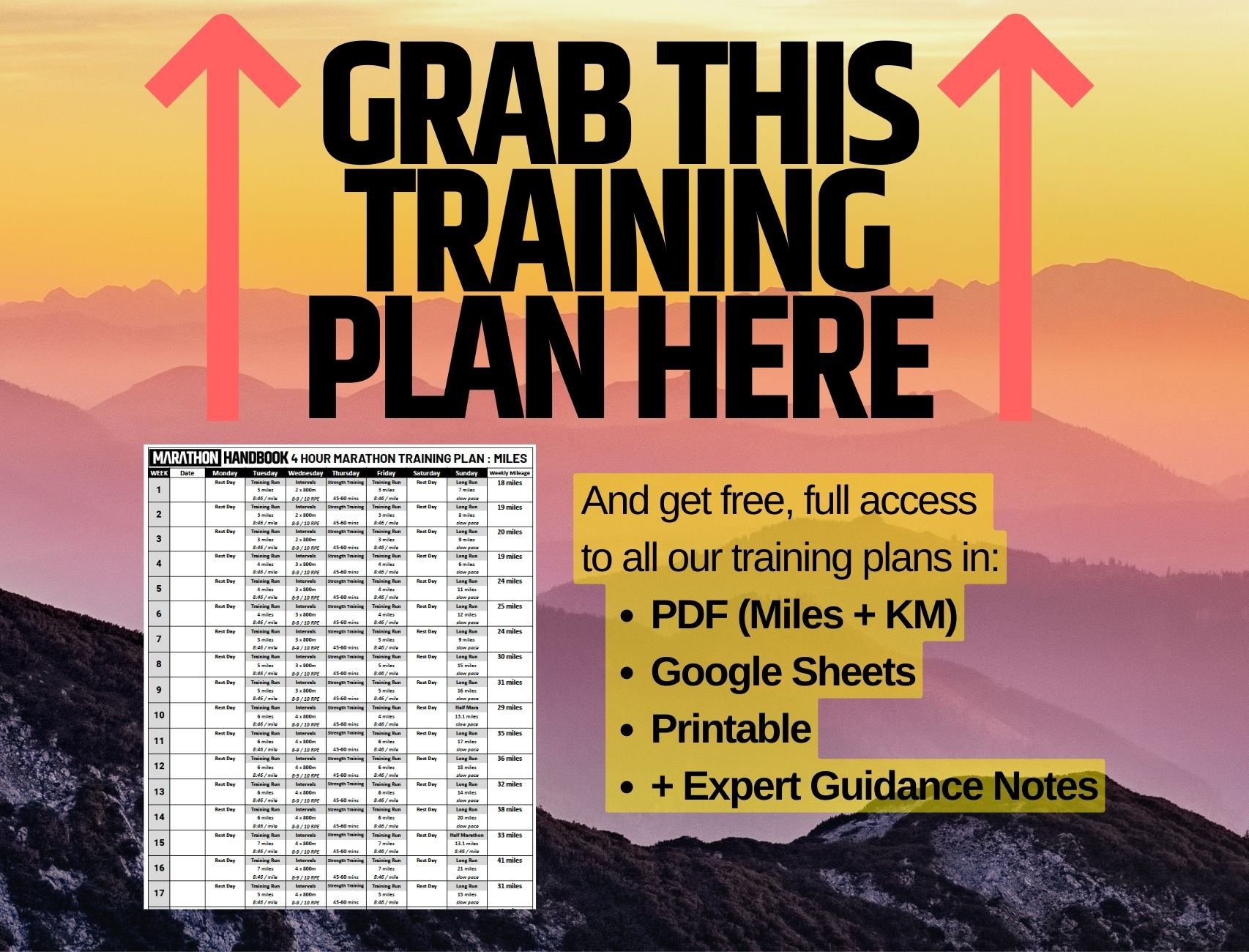Unlike shorter races like a 5k in which you might be able to get by and finish the race on very little training, especially if you perform other types of cardio workouts and maintain a decent level of fitness, success in the half marathon requires dedicated training and preparation.
A half marathon training plan for beginners will gradually help progress you to the full 13.1-mile distance by race day in a safe way.
Although there are many beginner half marathon training plans to choose from, in this guide, we’ve created a 15-week half marathon training plan for beginners to help you conquer the impressive half marathon race, even if you’re just getting started on your running journey.

Not sure this is the plan for you? – Check out our other half-marathon training plans.
How Far Is A Half Marathon?
A half marathon is 21.0975 kilometers, or 13.1 miles (rounded down from 13.1094), which is exactly half the distance of a full marathon.
15-Week Half Marathon Training Plan For Beginners: Essential Info
Our 15-week half marathon training plan for beginners is intended for runners who can currently run 2 miles without stopping. If you’re not quite up to that distance, consider our Couch to Half Marathon Training Plan, which will begin with the run/walk method.
There is also a slightly easier 16-week half marathon training plan for beginners and a shorter 12-week half marathon training plan for beginners if you only have three months to get in race-ready shape.

Here are a few tips for the workouts you will find in this beginner half marathon 12-week plan:
- Cross Training: Any form of non-running aerobic workout. Examples include cycling, swimming, rowing, elliptical, aqua jogging, and hiking.
- Distance Run: Base-building run to build endurance. These should be run at a comfortable pace—something around a 7 out of 10 on a rate of perceived exertion scale or a heart rate around 70-75% of your maximum heart rate.
- Easy Run: Run at a conversational pace to aid recovery from harder workouts. These should be a 6-7 on an RPE scale.
- Long Run: Long endurance workouts to improve physical and mental stamina.
- Threshold Workout and Tempo Run: Run at a pace you can sustain all out for one hour.
- Rest Day: Day off with no structured exercise. Focus on rest and recovery (stretching, foam rolling, taking it easy).
- Speed Workout: Run at various race paces (indicated) to build speed and mental and physical tolerance for running fast.
- Strides: short accelerations – a short burst of speed where you gradually accelerate as you go.
- Time Trial: Race-pace effort to assess your fitness level and rehearse the race experience.
- Shake Out Run: Very relaxed run to loosen up the day before a race or key workout.
When you’re ready, you can also check out our Half Marathon Pace Calculator to help plan your race speed based on your finish time goal.

Ready? Let’s get training!
Download The 15-Week Beginner’s Half Marathon Training Plan For Free:

Download The Training Plan Here
Enter your email, and I’ll send you this free training plan now, in PDF and Google Sheets formats (completely customizable), in both miles and kilometers.
After entering your email, you’ll be prompted to create an account on the Grow platform we use to control access to the plans. It’s completely free – make sure to complete the process to gain access to the plan!
Previous visitor or not seeing where to sign up?
Head over to our half marathon training plan database for full access to all plans.

| Monday | Tuesday | Wednesday | Thursday | Friday | Saturday | Sunday | |
| Cross-training: 30 minutes | Interval run: Warm up with 5 minutes of brisk walking, 5 x 1 minute running hard, 90 seconds jog Cool down 5 minutes of brisk walking | Distance run: 2 miles (3 km) | Rest | Threshold workout: Warm up and cool down 1/2 mile (1 km), 2 x 5 minutes at tempo pace with 90 sec recovery | Rest or 20 minutes of cross-training | Long run: 2 miles (3 km) | |
| Cross-training: 30-45 minutes | Interval run: Warm up with a 1-mile jog, 10 x 1 minute running hard, 60 seconds jog, Cool down 5 minutes of jogging | Distance run: 3 miles (5 km) | Rest | Threshold workout: Warm up and cool down 1 mile (2 km), 5 x 3 minutes at tempo pace with 90 sec recovery | Rest or 20 minutes of cross-training | Long run: 3 miles (5 km) | |
| Cross-training: 30-45 minutes | Speed workout: Warm up and cool down 1-2 miles (2-3 km); 10 x 400m at 5k pace with 200m jog | Distance run: 3 miles (5 km) | Rest | Threshold workout: Warm up and cool down 1 mile (2 km), 5 x 4 minutes at tempo pace with 90 sec recovery | Rest or Easy run: 4-5 miles (7-8 km) | Long run: 4 miles (6.5 km) | |
| Cross-training: 30-45 minutes | Speed workout: Warm up and cool down 1-2 miles (2-3 km); 6 x 800m at 5k pace with 200m jog | Distance run: 4 miles (7 km) | Rest | Threshold workout: Warm up and cool down 1 mile (2 km), 4 x 5 minutes at tempo pace with 90 sec recovery | Rest or Easy run: 4-5 miles (7-8 km) and 4 x 75m strides | Long run: 5 miles (8 km) | |
| Cross-training: 40-45 minutes | Speed workout: Warm up and cool down 1-2 miles (2-3 km); 6 x 1,000m at 5k pace with 200m jog | Distance run: 4 miles (7 km) | Rest | Threshold workout: Warm up and cool down 1 mile (2 km), 3 x 7 minutes at tempo pace with 90 sec recovery | Rest or Easy run: 4-5 miles (7-8 km) and 4 x 75m strides | Long run: 6 miles (10 km) | |
| Cross training: 40-45 minutes | Speed workout: Warm up and cool down 1-2 miles (2-3 km); 1 x 1600m at 5k pace with 200m jog; 4 x 800m at 5k pace with 200m jog | Distance run: 4 miles (7 km) | Rest | Threshold workout: Warm up and cool down 1 mile (2 km), 2 x 10 minutes at tempo pace with 90 sec recovery | Rest or Easy run: 4-5 miles (7-8 km) | Long run: 7 miles (11 km) | |
| Cross-training: 45 minutes | Speed workout: Warm up and cool down 1-2 miles (2-3 km); 4 x 800m at 5k pace with 200m jog, 4 x 400m at mile pace with 200m jog | Distance run: 4 miles (7 km) | Rest | Tempo run: Warm up and cool down 1 mile (2 km), 20 minutes at tempo pace | Rest or Easy run: 4-5 miles (7-8 km) and 4 x 75m strides | Long run: 6 miles (10 km) with the last 2 miles at goal half marathon pace | |
| Cross-training: 45 minutes | Speed workout: Warm up and cool down 1-2 miles (2-3 km); 6 x 1,000m at 5k pace with 200m jog | Distance run: 5 miles (8 km) | Rest | Tempo run: Warm up and cool down 1 mile (2 km), 25 minutes at tempo pace | Rest or Easy run: 4-5 miles (7-8 km) and 4 x 75m strides | Long run: 8 miles (12-13 km) | |
| Cross-training: 45 minutes | Speed workout: Warm up and cool down 1-2 miles (2-3 km); 3-4 x 1,600m at 5k pace with 400m jog | Distance run: 5 miles (8 km) | Rest | Tempo run: Warm up and cool down 1 mile (2 km), 30 minutes at tempo pace | Rest or Easy run: 4-5 miles (7-8 km) and 4 x 75m strides | Long run: 9 miles (15 km) | |
| Cross- training: 45-60 minutes | Speed workout: Warm up and cool down 1-2 miles (2-3 km); 5 x 1,200m at 5k pace with 200m jog | Distance run: 6 miles (10 km) | Rest | Tempo run: Warm up and cool down 1 mile (2 km), 35 minutes at tempo pace | Rest or Easy run: 4-5 miles (7-8 km) and 4 x 75m strides | Long run: 10 miles (16 km) | |
| Cross- training: 45-60 minutes | Speed workout: Warm up and cool down 1-2 miles (2-3 km); 6-8 x 600m at mile pace with 200m jog | Distance run: 7 miles (11 km) | Rest | Tempo run: Warm up and cool down 1 mile (2 km), 30 minutes at tempo pace | Rest or Easy run: 4-5 miles (7-8 km) and 4 x 75m strides | 10k time trial or race | |
| Cross-training: 45-60 minutes | Speed workout: Warm up and cool down 1-2 miles (2-3 km); 10 x 400m at mile pace with 200m jog | Distance run: 7 miles (11 km) | Rest | Tempo run: Warm up and cool down 1 mile (2 km), 40 minutes at tempo pace | Easy run: 4-5 miles (7-8 km) and 4 x 75m strides | Long run: 10 miles (16 km) | |
| Cross- training: 45-60 minutes | Speed workout: Warm up and cool down 1-2 miles (2-3 km); 6 x 1,000m at 5k pace with 200m jog | Distance run: 8 miles (12-13 km) | Rest | Tempo run: Warm up and cool down 1 mile (2 km), 40 minutes at tempo pace | Easy run: 4-5 miles (7-8 km) and 4 x 75m strides | Long run: 12 miles (19 km) | |
| Cross- training: 45-60 minutes | Speed workout: Warm up and cool down 1-2 miles (2-3 km); 8 x 800m at 5k pace with 200m jog | Distance run: 7 miles (11 km) | Rest | Threshold workout: Warm up and cool down 1 mile (2 km), 2 x 10 minutes at tempo pace with 90 sec recovery | Easy run: 4-5 miles (7-8 km) and 4 x 75m strides | Long run: 7 miles (11 km) | |
| Cross-training: 30-40 minutes | Speed workout: Warm up and cool down 1 mile (2 km), 4 x 800m at goal half marathon pace with 200m jog | Easy run: 4-5 miles (7-8 km) | Rest | Shake out: 20 minutes and 4 x 75m strides | Half Marathon | Rest |
Remember to listen to your body! Even if your training plan says to go for a run or do a workout of some sort, take a rest day or cross-training day if you’re super sore, tired, feel sick, or have a concerning ache.
Remember to fuel well1Murray, B., & Rosenbloom, C. (2018). Fundamentals of glycogen metabolism for coaches and athletes. Nutrition Reviews, 76(4), 243–259. https://doi.org/10.1093/nutrit/nuy001, stay hydrated, get plenty of rest, and believe in yourself. You can be a half-marathon finisher!

FAQs
What Should I Do If I Get Injured When Training For My First Half Marathon Race?
The most important point is to never run through your injury; you may worsen any damage done and then have to ditch your half marathon goals.
The good news is that most common running injuries can be diagnosed quickly and easily by a specialist, and often a rehab plan can be put in place that has minimal impact on your actual training plan.
Cross-training is something we’re huge advocates of – both for injury avoidance and performance, as well as adding volume to your training. All of our plans come with at least one cross-training day (though if you can squeeze in 2, even better).
In short, most injuries shouldn’t derail your race altogether as long as they are addressed early on.
As always – prevention is better than cure. Therefore, try a gentle 5-minute warm-up before starting your running workouts to reduce the chance of injury. This is particularly important for speed work or higher-intensity workouts that have a higher risk of injury.
What Kind Of Strength Training Should I Be Doing On Cross Training Days?
Cross training – and specifically strength training, or resistance training, is a huge tool in your half marathon training toolkit.
Not only does it help ward off weaknesses and imbalances that can lead to injury, but also makes you stronger, more powerful, and faster.
For the most bang for your buck, we recommend lifting weights. But, even if you just do bodyweight resistance workouts, you’ll notice a huge difference.
See Strength Training For Runners for our full guide on which specific muscles, exercises, and types of workout you should focus on.
What Shoes Should I Be Wearing?
Getting a good pair of running shoes is critical to half marathon success.
You don’t need the latest, carbon-plated, $300 performance shoes.
But equally, those old worn trainers in your closet probably aren’t ideal.
Here’s our complete guide on how to choose running shoes, and here are some recommended half marathon running shoes to check out.
What Should I Eat During Half Marathon Training
It’s important to be getting in the right fuel as your weekly mileage starts to increase and you undertake longer runs.
Make sure you’re getting a healthy balance of carbs, protein, and fats.
Check out our half-marathon nutrition guide for more details.
How To Customize Our Half Marathon Training Plans
Our half marathon training plans are completely free and fully customizable.
Do other commitments mean that you can only train on certain days?
Need to trim a couple of weeks off the training schedule?
No problem, edit the spreadsheet as you see fit.
Our training plans come in both Google Sheets and PDF format; feel free to grab a copy of the Google Sheet, edit it, download it to Excel, print it – do whatever you want!
Furthermore, you can choose to download the plans formatted into either kilometers or miles – whichever you’re used to.
Who Has Designed These Half Marathon Training Plans?
Hi!
I’m Thomas, a UESCA-certified running coach and ultra-runner.
I’ve worked with hundreds of runners and developed these training plans through ongoing research, my work with other marathon runners, and personal experience.
We’ve shared our marathon training plans online for free since 2016.
We’re big believers in marginal gains and constantly improving what we do, so over the years we have continually revisited and refined each of these free half marathon training plans as our knowledge – and feedback from our runners – has improved.
We also have a dedicated Facebook group where runners discuss our plans, their personal challenges, and share their finish line photos!



How Do These Plans Compare With Other Half Marathon Plans Available Online?
Alright, so you’ve probably googled ‘half marathon training plan‘ and seen there are many sites offering plans.
We’re big fans, and friends, with many of these coaches . . . for years before I became a coach, I followed Hal Higdon‘s training plans for each of my races, and credit Hal Higdon’s half marathon training plans for getting me through my first couple of halfs.
You’ll also find awesome plans from the likes of Runner’s World, Nike, Jeff Galloway, and major race organizers – I’d encourage you to check them out and compare them to our free plans before you commit to a specific plan. Always choose the plan that looks right for you.
Our plans differ from other plans you’ll find online in that they are:

#1. Customizable / Free To Edit
We’re big believers that there’s no one-size-fits-all training plan. You can grab a free copy of any plan and move things around to suit you using either Google Sheets, Excel, or similar software.
Want to cut off the first couple of weeks and jump in at week 3?
Need to move a weekly workout to suit your existing commitments or family?
Need to adjust things because of an illness, injury, or just feeling the need for a break?
That’s why a customizable, dynamic training plan is so important – your training plan should work for you, not the other way around.
They also come in free, handy half marathon training program PDF files if you don’t need to make any changes!
#2. Include Extensive Guidance Notes
Each plan includes a page of notes that walk you through the rationale of the plan, and how to perform every single workout.
We tell you how hard to push it (either in terms of a specific pace or RPE), give you tips for how to do each workout, and walk you through how to train towards your race pace.
#3. We Follow Up With More Helpful Material (All Free)
We’ve been helping runners train for the half marathon distance for many years now, so we know all the main sticking points and common problems that are faced.
So when anyone signs up for one of our plans, we stay in touch – after you get your plan, we’ll pepper your inbox every couple of days with tips and training strategies specific to your marathon journey.
Not interested in extra material? Just unsubscribe at any time.
#4. We Want To Keep Getting Better
We’re constantly getting feedback from runners on our plans – everything from the workout frequency to the clarity of information to the suitability of the runner’s experience level. We also work hard on the plan format to ensure it’s clear, easy to follow, edit, and print off, and is best suited to the runner.
That’s why we’re constantly revisiting our plans; we did a major overhaul in 2023 and are constantly making small tweaks to improve them.
#5. We Are A Support Community
Through our in-house coaches and runners, our Facebook group of over 20,000 runners, and our Instagram community, we want to make sure you’ve got the support and training tips you need as you undertake your half marathon training journey.
Don’t You Have A Half Marathon Training App?
Actually, we do!
We’ve partnered with TrainingPeaks to offer all of our training plans through their app, where you get more in-depth information about each workout, you can follow along with target pace and exertion levels in real-time, and log your training directly in the app itself.
We do charge for these premium training plans – but it’s less than half the price of a pair of running shoes, so if you’re interested, check out our TrainingPeaks Half Marathon Training Plans.


If All This Is Really Free, How Do You Folks Make Money?
We keep ourselves going by charging for a couple of premium products we’ve put out there: our TrainingPeaks Training Plans, and our Half Marathon Masterclass.
The Masterclass is designed for any runner who really wants to dive deep into their half marathon training: it includes over 6 hours of video tutorials on everything from injury prevention, nutrition, race day strategies, hydration, and more.
But – feel free to just grab a free training plan and be on your way!
Other Suggested Half Marathon Training Plans
Beginner + Novice Training Plans
- Couch To Half Marathon Training Plan
- 5k To Half Marathon Training Plan
- Beginner 16 Week Half Marathon Training Plan
- 12 Week Half Marathon Training Plan
Intermediate + Advanced Half Marathon Training Plans
- 10k To Half Marathon Training Plan
- 10 Week Improver Half Marathon Training Plan
- 8 Week Half Marathon Training Plan
- 6 Week Half Marathon Training Plan
- 4 Week Half Marathon Training Plan
Time-based Half Marathon Training Plans
- Sub 2-Hour Half Marathon Training Plan
- 1:45 Half Marathon Training Plan
- 1:30 Half Marathon Training Plan – 12 Weeks
- 1:30 Half Marathon Training Plan – 8 Weeks
Check out the Half Marathon Training Plans page for more.












